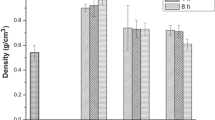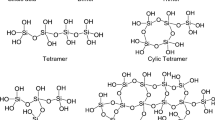Abstract
The use of fast-growing wood can reduce the environmental impact of the wood industry, but the low strength and flammability of these woods prevent their widespread application. Chinese fir not only has the general defect of fast-growing wood, but also has weak permeability due to aspirated pits. To improve its performance, environment-friendly modifier sodium silicate (SS) and WEP (waterborne epoxide resin) as the dipping solution, microwave pretreatment and multi-step emptying-pressure (MSEP) impregnation method were employed to prepare hybrid-modified wood. Microwave pretreatment was found to destroy pit membranes of Chinese fir and increase permeability. WEP addition reduced the wood’s -OH content and promoted formation of more Si–O–Si structures, while also forming a fusiform hybrid structure with SS through Si–O–C bonds. The mechanical properties and water resistance of SS/WEPW (hybrid-modified wood) were higher than those modified by SS alone. The bending strength, elastic modulus, compressive strength, and transverse, tangential, and radial hardness of SS/WEPW5% (5% WEP) reached 97.20, 8504.87, 57.73, 5113.50, 2536.37, and 2192.35 MPa, respectively. The water resistance performance was also significantly improved. Compared with SSW, the 7-day weight leaching ratio (WLR) and water absorption rate (WAR) were reduced by 49.26 and 11.09, respectively, and the 14-day anti-shrink efficiency (ASE) of SS/WEPW5% can reach 86.87%. Furthermore, the flame retardant and smoke suppression performances of hybrid-modified wood were also improved, with the heat release rate (HRR), smoke produce rate (SPR), mean carbon monoxide yield (mean COY), and mean carbon dioxide yield (mean CO2Y) of SS/WEPW5% significantly lower and the peak of CO and CO2 release almost 1/10th that of unmodified wood. SS/WEP hybrid-modified wood was improved in terms of mechanical properties, water resistance performance, and flame retardancy, which laid the foundation of its use as a high-performance wooden material.








Similar content being viewed by others
References
Chen L, Wang YJ, Zia-ud-Din FP, Jin WS, Xiong HG, Wang JZ (2017) Enhancing the performance of starch-based wood adhesive by silane coupling agent (KH570). Int J Biol Macromol 104:137–144. https://doi.org/10.1016/j.ijbiomac.2017.05.182
Chu D, Mu J, Zhang L, Li Y (2017) Promotion effect of NP fire retardant pre-treatment on heat-treated poplar wood. Part 2: hygroscopicity, leaching resistance, and thermal stability. Holzforschung 71(3):217–223. https://doi.org/10.1515/hf-2016-0213
Dai JY, Peng YY, Teng N, Liu Y, Liu CC, Shen XB, Sakil M, Zhu J, Liu XQ (2018) High performing and fire resistant biobased epoxy resin from renewable sources. ACS Sustain Chem Eng 6(6):7589–7599. https://doi.org/10.1021/acssuschemeng.8b00439
Erchiqui F, Kaddami H, Dituba-Ngoma G, Slaoui-Hasnaoui F (2020) Comparative study of the use of infrared and microwave heating modes for the thermoforming of wood-plastic composite sheets. Int J Heat Mass Tran 158:119996–120007. https://doi.org/10.1016/j.ijheatmasstransfer.2020.119996
Furuno T, Imamura Y (1998) Combinations of wood and silicate Part 6. Biological resistances of wood-mineral composites using water glass-boron compound system. Wood Sci Technol 32:161–170. https://doi.org/10.1007/BF00704839
Garskaite E, Karlsson O, Stankeviciute Z, Kareiva A, Jonesa D, Sandberga D (2019) Surface hardness and flammability of Na2SiO3 and nano-TiO2 reinforced wood composites. RSC Adv 9:27973–27986. https://doi.org/10.1039/c9ra05200c
Guo BT, Liu YZ, Zhang Q, Wang FQ, Wang QW, Liu YX (2017) Efficient flame-retardant and smoke-suppression properties of Mg-Al-layered double-hydroxide nanostructures on wood substrate. ACS Appl Mater Inter 23:39–47. https://doi.org/10.1021/acsami.7b06803
Guo HZ, Luković M, Mendoza M, Christian M, Schlepütz C, Griffa M, Xu BW, Gaan S, Herrmann H, Burgert I (2019) Bioinspired struvite mineralization for fire resistant wood. ACS Appl Mater Inter 11(5):19967–19989. https://doi.org/10.1021/acsami.8b19967
Guo H, Özparpucu M, Windeisen-Holzhauser E, Schlepütz CM, Quadranti E, Gaa S, Dreimol C, Burgert I (2020) Struvite mineralized wood as sustainable building material: mechanical and combustion behavior. ACS Sustain Chem Eng 28:10402–10412. https://doi.org/10.1021/acssuschemeng.0c01769
Huang YG, Li GY, Chu FX (2019) Modification of wood cell wall with water-soluble vinyl monomer to improve dimensional stability and its mechanism. Wood Sci Technol 53:1051–1060. https://doi.org/10.1007/s00226-019-01112-0
Jiang J, Cao J, Wang W (2017) Characteristics of wood-silica composites influenced by the pH value of silica sols. Holzforschung 72(4):311–319. https://doi.org/10.1515/hf-2017-0126
Kumar A, Staněk K, Ryparová P, Hajek P, Tywoniak J (2016) Hydrophobic treatment of wood fibrous thermal insulator by octadecyl trichlorosilane and its influence on hygric properties and resistance against moulds. Compos Part-B Eng 106:285–293. https://doi.org/10.1016/j.compositesb.2016.09.034
Li XY, Gao YL, Zhang MH (2017) Water migration in poplar wood during microwave drying studied by time domain nuclear magnetic resonance (TD-NMR). Holzforschung 71(11):881–887. https://doi.org/10.1515/hf-2017-0040
Li Z, Liu Z, François D, Yan L, Wang DY (2018) Interfacial engineering of layered double hydroxide toward epoxy resin with improved fire safety and mechanical property. Compos Part-B Eng 152(1):336–346. https://doi.org/10.1016/j.compositesb.2018.08.094
Li P, Zhang Y, Zuo YF, Lu JX, Yuan GM, Wu YQ (2019) Preparation and characterization of sodium silicate impregnated Chinese fir wood with high strength, water resistance, flame retardant and smoke suppression. J Mater Res Technol 9(1):1043–1053. https://doi.org/10.1016/j.jmrt.2019.10.035
Li P, Zhang Y, Zuo YF, Wu YQ, Yuan GM, Lu JX (2021) Comparison of silicate impregnation methods to reinforce Chinese fir wood. Holzforschung 75(2):126–137. https://doi.org/10.1515/hf-2020-0016
Lin WS, Huang YD, Li J (2018) Preparation of highly hydrophobic and anti-fouling wood using poly(methyl hydrogen)siloxane. Cellulose 25:7341–7353. https://doi.org/10.1007/s10570-018-2074-y
Lindholm J, Brink A, Wilen C-E, Hupa MH (2012) Cone calorimeter study of inorganic salts as flame retardants in polyurethane adhesive with limestone filler. J Appl Polym Sci 123(3):1793–1800. https://doi.org/10.1002/app.34641
Liu Z, Gao ZJ (2018) Fabrication of superhydrophobic wood surface with a silica/silicone oil complex emulsion. Wood Res 63(2):353–364
Liu C, Wang S, Shi J, Wang C (2011) Fabrication of superhydrophobic wood surfaces via a solution-immersion process. Appl Surf Sci 11:761–765. https://doi.org/10.1016/j.apsusc.2011.08.077
Liu CZ, Mei CT, Xu B, Jiang M, Chen WM, Zhou GQ, Wang K (2018) Effect of the nanosilica content in the shell of coextruded wood-plastic composites to enhance the ultraviolet aging resistance. Polym Adv Technol 30:1–8. https://doi.org/10.1002/pat.4454
Liu ML, Li CF, Liu YL (2019) Physical and mechanical properties of modified poplar wood by heat treatment and impregnation of sodium silicate solution. Wood Res 64(1):145–154. https://doi.org/10.15376/biores.12.1.2004-2014
Lykidis C, Moya R, Tenorio C (2020) The effect of melamine formaldehyde impregnation and hot-pressing parameters on the density profile of densified poplar wood. Eur J Wood Prod 78:433–440. https://doi.org/10.1007/s00107-020-01515-y
Mubarok M, Dumarcay S, Militz H, Candelier K, Thévenon MF, Gérardin P (2019) Non-biocide antifungal and anti-termite wood preservation treatments based on combinations of thermal modification with different chemical additives. Eur J Wood Prod 77:1125–1136. https://doi.org/10.1007/s00107-019-01468-x
Najafi A, Golestani-Fard F, Rezaie HR, Ehsani N (2011) A study on sol-gel synthesis and characterization of SiC nano powder. J Sol-Gel Sci Technol 59:205–214. https://doi.org/10.1007/s10971-011-2482-z
Qin YL, Dong YM, Li JZ (2019) Effect of modification with melamine-urea-formaldehyde resin on the properties of eucalyptus and poplar. J Wood Chem Technol 54:1223–1239. https://doi.org/10.1080/02773813.2019.1636821
Rosu L, Mustata F, Varganici C, Rosu D, Rusu T, Rosca I (2019) Thermal behaviour and fungi resistance of composites based on wood and natural and synthetic epoxy resins cured with maleopimaric acid. Polym Degrad Stabil 160:148–161. https://doi.org/10.1016/j.polymdegradstab.2018.12.022
Schwarzkopf M (2019) Densified wood impregnated with phenol resin for reduced set-recovery. Wood Mater Sci Eng 265:120862–120869. https://doi.org/10.1080/17480272.2020.1729236
Segal L, Creely JJ, Martin AE, Conrad CM (1959) An empirical method for estimating the degree of crystallinity of native cellulose using the X-Ray diffractometer. Text Res J 29(10):786–794. https://doi.org/10.1177/004051755902901003
Seo HJ, Kim S, Huh W, Park KW, Lee DR, Kim S (2016) Enhancing the flame-retardant performance of wood-based materials using carbon-based materials. J Therm Anal Calorim 123:1935–1942. https://doi.org/10.1007/s10973-015-4553-9
Shi Y, Lv WH, Wang XY (2020) Modification process and properties of fast grown Chinese fir wood with melamine-urea-formaldehyde resin and dye compound. China Wood Ind 34(1):15–19. https://doi.org/10.19455/j.mcgy.20200104
Tao Y, Li P, Cai L, Shi SQ (2019) Flammability and mechanical properties of composites fabricated with CaCO3-filled pine flakes and phenol formaldehyde resin. Compos Part-B Eng 167(15):1–6. https://doi.org/10.1016/j.compositesb.2018.12.005
Toba K, Yamamoto H, Yoshida M (2013) Crystallization of cellulose microfibrils in wood cell wall by repeated dry-and-wet treatment, using X-ray diffraction technique. Cellulose 20:633–643. https://doi.org/10.1007/s10570-012-9853-7
Tu KK, Wang XQ, Kong LZ (2018) Facile preparation of mechanically durable, self-healing and multifunctional superhydrophobic surfaces on solid wood. Mater Design 140:30–36. https://doi.org/10.1016/j.matdes.2017.11.029
Unger B, Bücker M, Reinsch S, Hübert T (2013) Chemical aspects of wood modification by sol–gel-derived silica. Wood Sci Technol 47:83–104. https://doi.org/10.1007/s00226-012-0486-7
Wang XZ, Chen XZ, Xie XQ (2019) Multi-Scale Evaluation of the effect of phenol formaldehyde resin impregnation on the dimensional stability and mechanical properties of Pinus Massoniana Lamb. Forests Sci 10(8):646–658. https://doi.org/10.3390/f10080646
Wang QL, Xiao SL, Shi QS (2019) The effect of hemicellulose content on mechanical strength, thermal stability, and water resistance of cellulose-rich fiber material from poplar. BioResources 14(3):5288–5300. https://doi.org/10.15376/biores.14.3.5288-5300
Wang ZH, Zou WH, Sun DL, Ji XQ, Yu MG (2020) Fabrication and performance of in-depth hydrophobic wood modified by a silica/wax complex emulsion combined with thermal treatment. Wood Sci Technol 54:1223–1239. https://doi.org/10.1007/s00226-020-01214-0
Xi JB, Zhou EZ, Liu YJ (2017) Wood-based straightway channel structure for high performance microwave absorption. Carbon 124:492–498. https://doi.org/10.1016/j.carbon.2017.07.088
Xu EG, Zhang YJ, Lin LY (2020) Improvement of mechanical, hydrophobicity and thermal properties of Chinese fir wood by impregnation of nano silica sol. Polymers 12(8):1632. https://doi.org/10.3390/polym12081632
Xuan LN, Fu YL, Liu ZG (2018) Hydrophobicity and photocatalytic activity of a wood surface coated with a Fe3+ Doped SiO2/TiO2 film. Materials 11:2594. https://doi.org/10.3390/ma11122594
Yao MM, Yang YQ, Song JL, Yu Y, Jin YC (2017) Melamine formaldehyde modified furfurylation to improve Chinese fir’s dimensional stability and mechanical properties. BioResources 12:3057–3066. https://doi.org/10.15376/biores.12.2.3057-3066
Yue K, Wu JH, Xu L, Tang ZQ, Chen ZJ, Liu WQ, Wang L (2020) Use impregnation and densification to improve mechanical properties and combustion performance of Chinese fir. Constr Build Mater 241:118101–118109. https://doi.org/10.1016/j.conbuildmat.2020.118101
Zhen X, Zhang J, Zhang BX et al (2012) Effect of flame retardants on mechanical properties, flammability and foamability of PP wood-fiber composites. Compos Part-B Eng 43:150–158. https://doi.org/10.1016/j.compositesb.2011.06.020
Zhou Y, Zhang Y, Zuo YF, Wu YQ, Yuan GM, Li XJ (2020) Construction of a network structure in Chinese fir wood by Na2SiF6 crosslinked Na2SiO3. J Mater Res Technol 9(6):14190–14199. https://doi.org/10.1016/j.jmrt.2020.10.033
Acknowledgements
This research was supported by National Natural Science Foundation of China (31770606), Hunan Provincial Technical Innovation Platform and Talent Program in Science and Technology, PR China (2019S2040) and Science and Technology Innovation Project for Postgraduates of Central South University of Forestry and Technology, PR China (CX20202020).
Author information
Authors and Affiliations
Corresponding author
Ethics declarations
Conflict of interest
The authors declare no competing financial interest.
Additional information
Publisher's Note
Springer Nature remains neutral with regard to jurisdictional claims in published maps and institutional affiliations.
Rights and permissions
About this article
Cite this article
Sun, Z., Lv, J., Wang, Z. et al. Sodium silicate/waterborne epoxy resin hybrid-modified Chinese fir wood. Wood Sci Technol 55, 837–855 (2021). https://doi.org/10.1007/s00226-021-01287-5
Received:
Accepted:
Published:
Issue Date:
DOI: https://doi.org/10.1007/s00226-021-01287-5




